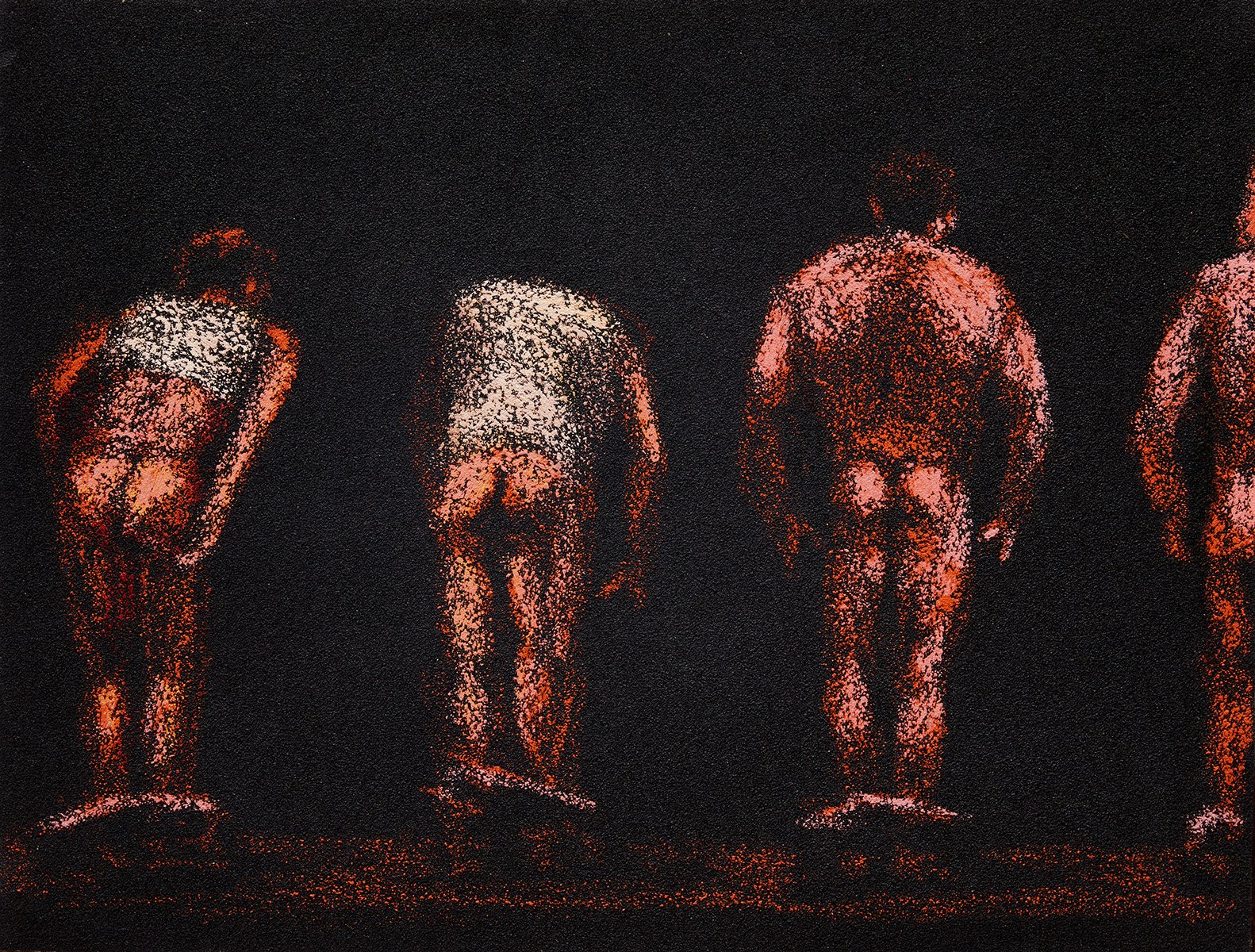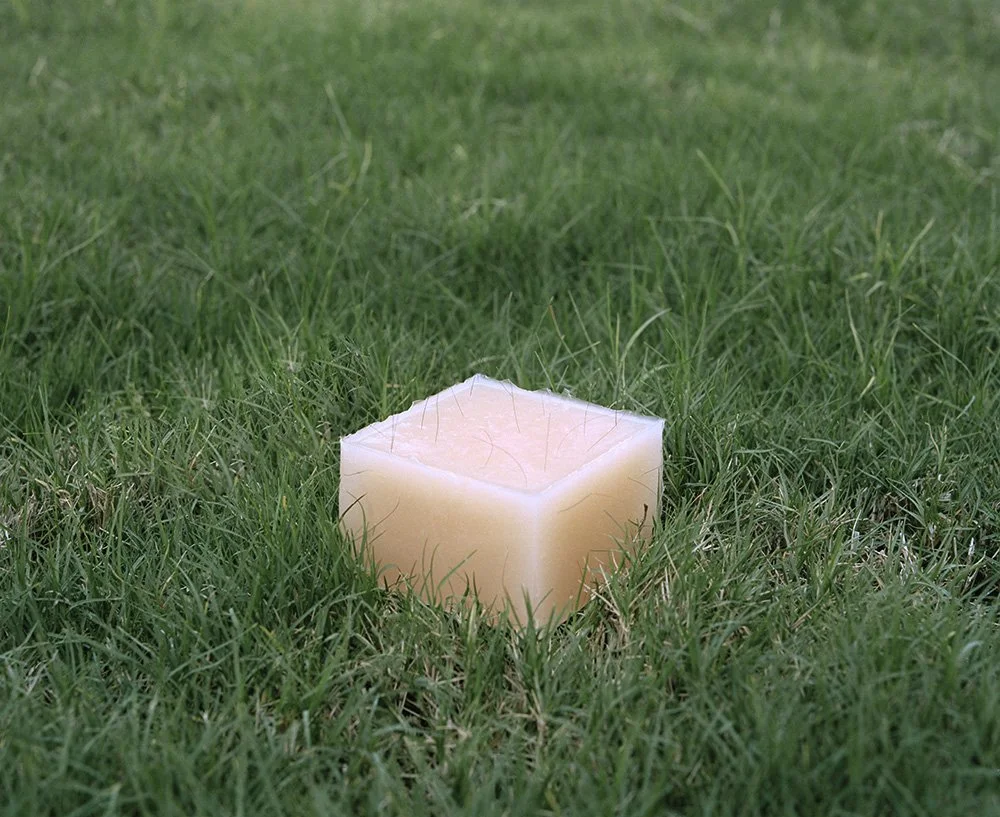Exhibition Review: Feeling the Space
© Jane Dickson, “All Male 5,“ 1993, Oil stick on sandpaper, Courtesy of James Fuentes LLC, New York City.
Written by Emily Capone
Edited by Ben Blavat
A tribute to Yoko Ono’s 1973 album, the “Feeling the Space” group exhibition at ClampArt transcends the space that lies between sexuality and the male gaze. With a focus on bold and sensual imagery, societal norms are challenged through the lenses of artists Jane Dickson, Ann Weathersby, Marianna Rothen and Natasha Gornik. As a first impression, I took in these artists’ pieces as raw and tragic. Ironic, I thought — how the silent gaze of a patriarchal society could only make me think that sexual expression through objectification could be anything but powerful.
Curated by Lissa Rivera, this collection is not bombastic, nor is it light. It is exactly what it needs to be: a peek into these forbidden spaces. An example of this would be in Dickson’s paintings of pre-Guiliani Times Square sex shows. Dickson’s paintings are rough in a literal way, with the use of oil on sandpaper, and in the figurative sense, with the seductive glow that seems to emanate from behind each shadowy figure. Dickson captures a sex worker amid movement, as demonstrated in Gaitey 6, and this image of a male figure swaying in tandem with the moment that is passing between spaces appears primal. The “fear” of being admitted into a male-dominated space creates tension, yet Dickson’s interpretation of something that is seen as darkly evocative becomes an invitation into nocturnal beauty.
© Marianna Rothen, “When I’m 18,“ 2020, Archival pigment prints (diptych), Courtesy of ClampArt, New York City.
In another sense, the silent gaze of a patriarchal society begins from within at a young age. And as we grow, the questions we pose become less of a challenge and more of an understanding for what we should aspire to be, what we should conform to. I found Ann
Weathersby’s Suddenly I see myself as another, as another would be seen, outside myself, available to all eyes to best challenge this way of thinking. The focus on the female body is clear: The poses of each image are seen as demure, controlled, sensual, and the use of products such as blood, wood and glass replicate the changes from pubescent innocence to a matured knowledge of the physical body. In each display, Weathersby has either covered the eyes and face of the female image or placed it on display behind glass, or on a shelf, as an incandescent window into the sexual objectification of the female body and the internal question of gender and its role in society.
© Ann Weathersby, “I shift and change and am seen through in a second,“ 2021, Kiln-formed glass and wooden shelf, Courtesy of ClampArt, New York City.
This role is also showcased in Marianna Rothen’s diaries, which lay bare for all to see next to images of mannequins, a subjectification of the boys within her pubescent fantasies. Her drive to control and to submit are focused within eerie snapshots, as in When I’m 18, which shows a man’s mannequin hand wearing a watch and fondling a pair of satin underwear meant for a girl. Taped to the wall within the same display is a diary entry from when she was 12 to 16 years old, displaying her dreams of lust. In a fit of passion, the teenage Rothen explores her sexual needs, which are considered base and licentious in the puritanical sense, yet there is power in her desire to control the physical space, to do it in the “garden under the stars.”
As with Rothen, Natasha Gornik explores these spaces of objectification, but within the private terrain of a BDSM community in which the identity is obscured. Gornik uses darkness and light to peel back the layers behind the curtain, as in The Dojo, which has the appearance of disempowerment, but with the understanding that each character (the male figure and the hidden female figure) is each at the mercy of the other. This image leaves the viewer to question the true power of sexual objectification, and why this space contains both risk and pleasure.
After experiencing this exhibition, I don’t think the question we should be asking ourselves is what we think of this “space.” Through each artist’s medium, the public is brought into the world of risk and pleasure to understand, experience, and observe. These spaces draw on the raw elements of puberty, teenage lust, and exclusivity, bringing them to the forefront through an artist’s lens. As Lissa Rivera so eloquently states in her own exhibition, “Beautiful Boy,” “The camera transposes our private experiences into public expression.” In the end, then, maybe the question we should ask ourselves is not what we think of this space, but of how we can and should enter it.
© Natasha Gornik, “The Dojo,“ 2010, Archival pigment print, Courtesy of ClampArt, New York City.
“Feeling the Space” is on view at ClampArt in New York.










